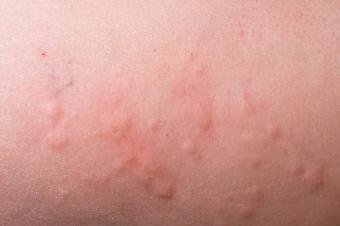
Everyday tasks like cleaning the house, working with paints or dyes, or even gardening can lead to skin irritation. Understanding what causes irritated skin and how it looks will help you treat it successfully.
Causes
The skin serves as a barrier against infections and contaminants. Most of the time it works very well. However, some substances can irritate the skin and lead to an uncomfortable and unsightly rash. An itchy, blistering rash may be due to an allergic reaction. A red, scaly, and perhaps slightly swollen rash is more likely to be caused by an irritant. The medical term for this type of rash is contact dermatitis.
Common causes of skin irritation include:
- Detergents, such as those used in housecleaning or frequent handwashing
- Rough materials, like fiberglass insulation in construction
- Spiny plants, which gardeners and farmers may handle regularly
- Chemicals, including hair dyes and permanents, cleaning materials, and lab supplies
Recognizing the Rash

Irritant rashes tend to be scaly or dry, with reddening and/or cracking of the skin. The skin may appear thickened or fissured. There may be small blisters, but they are usually not predominant. However, different substances may cause different symptoms. The hands are the most commonly affected site, but any area of the skin that comes in contact with the irritant can develop a rash. There may be pain, burning, or stinging. Itching is usually a less prominent symptom.
Making the Diagnosis
Identifying the offending substance is an important step in treating contact dermatitis. The timing of your symptoms can help. If the skin irritation is caused by substances in your work place, you may find that the rash improves on the weekend, only to get worse again on Monday. Conversely, if the weekend is your time to clean house, you may find that a detergent-related rash heals by Friday, only to reappear when the work week is over.
With some substances, particularly detergents, irritation tends to get worse the more the irritant is used. For example, nurses who must wash their hands many times a day tend to develop contact dermatitis more often than colleagues who do not need to wash their hands as much. If you use soaps or chemicals frequently, they may be at fault. This kind of skin irritation can develop slowly over days or even weeks.
If there is no obvious culprit, you may need to think back over your activities in the past few days. There are many substances that cause irritation, but some have a delayed effect that may take a day or two to appear. Did you use any new chemicals or try a new activity recently? It may also be helpful to compare notes with co-workers and family members. Is anyone else having the same symptoms?
Skin Irritation vs. Skin Allergy
Irritant skin rashes tend to look and feel differently than allergic rashes. Allergic rashes tend to be itchier and are more likely to have blisters, but sometimes it's difficult to be sure.
If others at your workplace, hobby group, class, or other activity have developed similar rashes, it's more likely to be due to an irritant than an allergy. It would be unusual for many people to develop the same allergy all at once.
If the cause is really unclear, your doctor may choose to do a patch test. This involves placing small bandages containing potential allergens on your skin. The bandages must stay in place for about three days. If a similar rash develops in response to one of the allergens, it's likely that you have a skin allergy.
Treatment
The primary treatment is avoidance of the irritant. Protective gloves and clothing may be needed. For people who develop rashes due to frequent handwashing, switching to soap-free cleansers or alcohol-based hand sanitizers may help. Gentle moisturizers that help create a protective barrier may also be of use.







